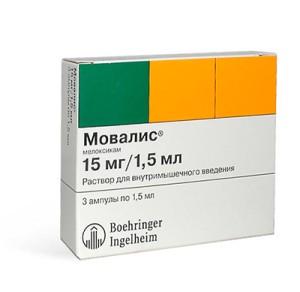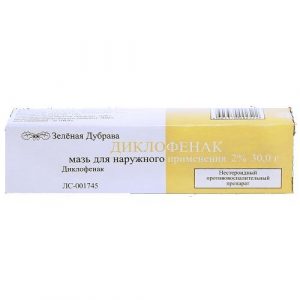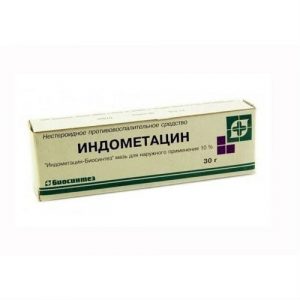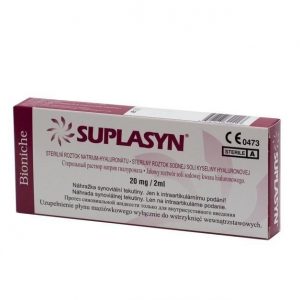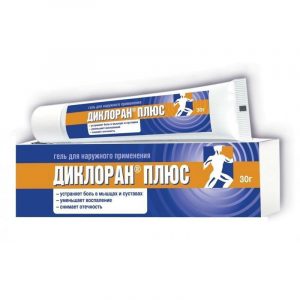Description
Release form
Intramuscular solution.
Packing
5 ampoules.
Pharmacological action
Movalis – analgesic, antipyretic, anti-inflammatory.
Pharmacodynamics
Movalis is an NSAID that belongs to enolic acid derivatives and has anti-inflammatory, analgesic and antipyretic effects. The pronounced anti-inflammatory effect of meloxicam is established on all standard models of inflammation. The mechanism of action of meloxicam is its ability to inhibit the synthesis of PG – known inflammatory mediators.
Meloxicam in vivo inhibits GHG synthesis at the site of inflammation to a greater extent than in the gastric mucosa or kidneys.
These differences are associated with more selective inhibition of COX-2 compared to COX-1. It is believed that inhibition of COX-2 provides the therapeutic effects of NSAIDs, whereas inhibition of the constantly present COX-1 isoenzyme may be responsible for side effects from the stomach and kidneys. The selectivity of meloxicam in relation to COX-2 is confirmed in various test systems, both in vitro and in vivo. The selective ability of meloxicam to inhibit COX-2 is shown when using in vitro human whole blood as a test system. It was found that meloxicam (at doses of 7.5 and 15 mg) more actively inhibited COX-2, exerting a greater inhibitory effect on the production of PGE2 stimulated by lipopolysaccharide (a reaction controlled by COX-2) than on the production of thromboxane, which is involved in blood coagulation (reaction , controlled by COX-1). These effects were dose dependent.
Ex vivo showed that meloxicam at the recommended doses did not affect platelet aggregation and bleeding time, unlike indomethacin, diclofenac, ibuprofen and naproxen, which significantly inhibited platelet aggregation and increased bleeding time. In clinical studies, side effects from the gastrointestinal tract as a whole occurred less frequently when taking meloxicam 7.5 and 15 mg than when taking other NSAIDs with which comparison was made. This difference in the frequency of side effects from the gastrointestinal tract is mainly due to the fact that when taking meloxicam, phenomena such as dyspepsia, vomiting, nausea, and abdominal pain were less common. The frequency of perforations in the upper gastrointestinal tract, ulcers and bleeding, which were associated with the use of meloxicam, was low and depended on the dose of the drug.
Pharmacokinetics
Meloxicam is completely absorbed after i / m administration. Relative bioavailability compared with oral bioavailability is almost 100%. Therefore, when switching from injectable to oral forms of dose selection is not required. After administration of 15 mg drug / m, a peak plasma concentration of about 1.62 μg / ml is reached within approximately 60 minutes. Meloxicam binds very well to plasma proteins, mainly with albumin (99%). Penetrates into the synovial fluid, the concentration in the synovial fluid is approximately 50% of the plasma concentration. Vd low, an average of 11 liters. Interindividual differences make up 30 40%.
Contraindications
hypersensitivity to the active ingredient or auxiliary components of the drug. There is a possibility of cross-hypersensitivity to acetylsalicylic acid and other NSAIDs
symptoms of bronchial asthma, nasal polyps, angioedema or urticaria after taking acetylsalicylic acid or other NSAIDs in the history of
peptic ulcer / perforation of the gastric and duodenal ulcer or duodenal ulcer acute ulcerative colitis
severe liver failure
severe renal failure (if hemodialysis is not performed, Cl cre Yining less than 30 ml / min, as well as with confirmed hyperkalemia), progressive kidney disease
acute gastrointestinal bleeding, recent cerebrovascular bleeding or an established diagnosis of blood coagulation system
severe uncontrolled heart failure
pregnancy
breastfeeding arthritic coronary artery disease therapy.
Special instructions
Caution should be exercised (as with other NSAIDs) when treating patients with a history of gastrointestinal tract diseases. Patients with gastrointestinal symptoms should be observed regularly. In the event of a gastrointestinal ulcer or gastrointestinal bleeding, Movalis ® must be canceled.
As with other NSAIDs, gastrointestinal bleeding, ulcers and perforations that are potentially life-threatening to the patient can occur during treatment at any time, both in the presence of alarming symptoms or information about serious gastrointestinal complications in the anamnesis, and in the absence of these signs.
The consequences of these complications are generally more serious in the elderly. Particular attention should be paid to patients reporting the development of adverse events from the skin and mucous membranes. In such cases, the question of stopping the use of the drug Movalis should be considered.
NSAIDs inhibitsynthesis of prostaglandins in the kidneys, which are involved in the maintenance of renal perfusion. The use of NSAIDs in patients with reduced renal blood flow or a reduced volume of circulating blood can lead to decompensation of latent renal failure. After discontinuation of NSAIDs, kidney function is usually restored to its original level.
The most at risk of developing this reaction are elderly patients who have dehydration, congestive heart failure, cirrhosis, nephrotic syndrome or overt kidney disease
patients receiving diuretics, ACE inhibitors, angiotensin II receptor antagonists, as well as patients having undergone serious surgery leading to hypovolemia. In such patients, at the beginning of therapy, diuresis and renal function should be carefully monitored.
In rare cases, NSAIDs can cause interstitial nephritis, glomerulonephritis, medullary renal necrosis, or nephrotic syndrome.
In patients with end-stage renal failure who are on hemodialysis, the dose of Movalis ® should not exceed 7.5 mg. In patients with mild or moderate impaired renal function (that is, if creatinine clearance is greater than 25 ml / min), a dose reduction is not required.
When using the drug Movalis ® (as well as most other NSAIDs), an occasional increase in the level of transaminases or other indicators of liver function in blood serum has been reported. In most cases, this increase was small and transient. If the identified changes are significant or do not decrease over time, Movalis ® should be discontinued, and monitoring detected laboratory changes.
In patients with clinically stable liver cirrhosis, a dose reduction is not required.
Weakened or emaciated patients may be less likely to tolerate adverse events, therefore, such patients should be closely monitored. Caution (as in the case of other NSAIDs) should be observed in the treatment of elderly patients who are more likely to have impaired renal, liver and heart function.
The use of NSAIDs in conjunction with diuretics can lead to a delay in sodium, potassium and water, and affect the natriuretic effect of diuretics. As a result, in susceptible patients, there may be an increase in signs of heart failure or hypertension.
meloxicam, like other NSAIDs, it can mask the symptoms of an infectious disease.
The use of meloxicam, as well as other drugs that block cyclooxygenase / prostaglandin synthesis, can affect fertility, therefore it is not recommended for women who want to become pregnant. If there is a violation of the ability to conceive in women or to conduct a screening for infertility, it is necessary to consider the abolition of meloxicam.
There have been no special studies regarding the effect of the drug on the ability to drive vehicles and mechanisms. Patients with visual impairment, patients who note drowsiness or other disorders of the central nervous system should refrain from this activity.
Composition
Active ingredient: meloxicam 15 mg
Excipients: meglumine glycofurol poloxamer 188 (Pluronic F68) sodium chloride glycine sodium hydroxide water for injection.
Dosage and administration of
Intramuscular administration of the drug is indicated only during the first 2-3 days of therapy. Further treatment is continued with the use of enteral forms. The recommended dose is 7.5 mg or 15 mg once a day, depending on the intensity of the pain and the severity of the inflammatory process.
The maximum recommended daily dose is 15 mg.
The drug is administered by deep IM injection.
Considering possible incompatibilities, the contents of Movalis® ampoules should not be mixed in the same syringe with other drugs.
Impaired renal function. In patients with severe renal failure undergoing hemodialysis, the dose should not exceed 7.5 mg / day.
The drug can not be entered in / in.
Side effects of
Hematopoietic organs: changes in the number of blood cells, including changes in the white blood cell count, leukopenia, thrombocytopenia, anemia. The predisposing factor for the occurrence of cytopenia, apparently, is the simultaneous use of potentially myelotoxic drugs, in particular methotrexate.
On the part of the immune system: anaphylactic shock, anaphylactoid / anaphylactic reactions, other immediate hypersensitivity reactions.
From the side of the central nervous system: headache, dizziness, tinnitus, drowsiness, confusion, disorientation, mood changes.
From the gastrointestinal tract: gastrointestinal perforation, latent or obvious gastrointestinal bleeding, possibly fatal, gastroduodenal ulcers, colitis, gastritis, esophagitis, stomatitis, abdominal pain, dyspepsia, diarrhea, nausea, vomiting, constipation, bloating, belching, transient changes in liver function indicators (for example, an increase in transaminase or bilirubin activity), hepatitis.
From the side of the skin and skin appendages: toxic epidermal necrolysis, Stevens-Johnson syndrome, angioedema, bullous dermatitis, erythema multiforme, pruritus, skin rash, urticaria, photosensitivity.
Respiratory: asthma in patients allergic to acetylsalicylic acid or other NSAIDs.
On the part of the CCC: increased blood pressure, palpitations, flushing, swelling.
From the genitourinary system: acute renal failure, changes in renal function (increased levels of creatinine and / or urea in the blood serum), urination disorders, including acute urinary retention.
From the side of the organ of vision: conjunctivitis, visual impairment, including blurred vision.
Drug interactions
Other GH synthesis inhibitors, including HA and salicylates, when taken with meloxicam increase the risk of ulceration in the gastrointestinal tract and gastrointestinal bleeding (due to synergism of action) and therefore, their combination is not recommended. Concomitant use with other NSAIDs is not recommended.
SSRIs – increased risk of gastrointestinal bleeding.
Lithium preparations – NSAIDs increase the concentration of lithium in plasma by reducing its excretion by the kidneys. It is recommended to monitor the concentration of lithium during the appointment of Movalis ®, with a change in the dose of lithium preparations and their cancellation.
Methotrexate – NSAIDs reduce the tubular secretion of methotrexate, thereby increasing its plasma concentration and hematological toxicity, the pharmacokinetics of methotrexate does not change. In this regard, the simultaneous administration of Movalis ® and methotrexate in a dose of more than 15 mg / week is recommended. The risk of developing an interaction between NSAIDs and methotrexate may also occur in patients who use methotrexate in low doses, especially in patients with impaired renal function. Therefore, constant monitoring of the number of blood cells and kidney function is necessary.
The simultaneous use of meloxicam did not affect the pharmacokinetics of methotrexate at a dose of 15 mg per week, however, it should be borne in mind that the hematological toxicity of methotrexate is enhanced while taking NSAIDs.
With the combined use of meloxicam and methotrexate for 3 days, the risk of increasing the toxicity of the latter increases.
Contraception – NSAIDs reduce the effectiveness of intrauterine devices.
Diuretics – the use of NSAIDs in case of dehydration of patients is accompanied by a risk of acute renal failure.
Patients receiving Movalis ® and diuretics should maintain adequate hydration. Prior to treatment, a study of kidney function is necessary.
Antihypertensive drugs (beta-blockers, ACE inhibitors, vasodilators, diuretics) – NSAIDs reduce the effect of antihypertensive drugs due to inhibition of GHGs with vasodilating properties.
Angiotensin II receptor antagonists, when given together with NSAIDs, increase the decrease in glomerular filtration, which can lead to the development of acute renal failure, especially in patients with impaired renal function. In the case of combination therapy, kidney function should be monitored.
NSAIDs, acting on renal GHGs, may enhance cyclosporin nephrotoxicity.
When used in conjunction with meloxicam drugs that have a known ability to inhibit CYP2C9 and / or CYP3A4 (or are metabolized with the participation of these enzymes), the possibility of pharmacokinetic interaction should be taken into account.
The possibility of interaction with hypoglycemic drugs for oral administration cannot be ruled out.
With the simultaneous use of antacids, cimetidine, digoxin and furosemide, no significant pharmacokinetic interactions have been identified.
An overdose of
The antidote is not known, in case of an overdose of the drug should be carried out: gastric lavage and general supportive therapy. Clinical studies have shown that cholestyramine accelerates the elimination of meloxicam.
Storage Conditions
In a dark place at a temperature below 30 ° C.
Expiration 5
active substance
Meloxicam
Beringer Ingelyhaym, Austria
